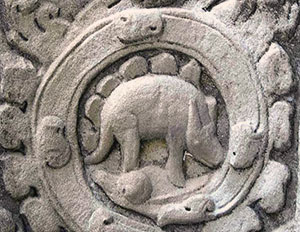
Credit: www.bible.ca
DRAFT Ver. 6b, © 2014-2017, Glen J. Kuban
Part of Kuban's Paluxy website
Note: This article is still in draft form. I invite visitors to submit any comments or corrections to me at gkpaleo@yahoo.com. Thanks!

|
|
Fig. 1. Alleged stegosaur carving at Ta Prohm Temple. Credit: www.bible.ca |
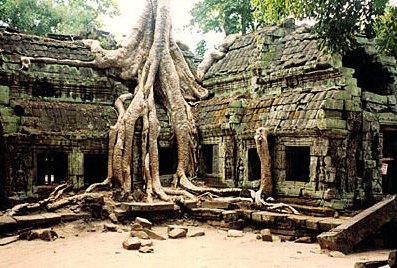
|
| Fig. 2. Ta Prohm Temple. Credit: PlaneWare.com |
* To clarify a couple issues of terminology before proceeding: Where not qualified elsewhere, I mean "dinosaurs" in the traditional sense, that is to say, non-avian dinosaurs. Technically, even today humans live with a large group of dinosaurs, called birds. Virtually all modern paleontologists regard birds as not only the descendents of dinosaurs, but as actual members of a dinosaur clad (feathered theropods to be more precise). The term "Stegosaurus" refers to a particular dinosaur genus, whereas "stegosaur" or "stegosaurid" refer to the whole group of similar dinosaurs with small heads, back plates or spines, and tail spikes, belonging to the suborder Stegosauria.
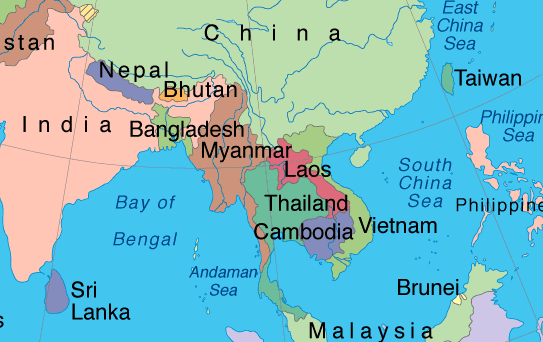
|
| Map of East Asia |
Ta Prohm is the modern name for a temple at Angkor, Cambodia. It was built in the late 1100's and early 1400's as a Buddhist monastery. Originally called Rajavihara, it was among many other Buddhist and Hindu temples produced by the Khmer civilization from the eighth through the fourteenth century A.D. The temple was commissioned by self-proclaimed "god-king" Jayavarman VII, one of the most renowned monarchs and builders of the empire. Statues depicting him in Buddha-like poses are found throughout the region. Ta Prohm was built in honor of his mother and dedicated in 1186. The temple's stele records that it was home to more than 12,500 people, including 18 high priests and 615 dancers, with 80,000 thousands more people in surrounding villages providing various services and supplies. Some question whether these figures may involve some exaggeration, but clearly the temple was an active and impressive complex.
The reign of Jayavarman VII was followed by that Jayavarman VIII, a strong believer in Hinduism, who sought to destroy many of the Buddhist structures and icons created during the rule of his famous predecessor. Ta Prohm did not entirely escape this onslaught. Many temple carvings and sculptures were removed or damaged, although many original carvings and latter additions can still be seen. Indeed, like other temples in the region, Ta Prohm was later expanded and modified until the end of the 13th century. Many of the additions reflect influences of various Buddhist and Hindu sects from India and other regions, with which the temple community had frequent contact.
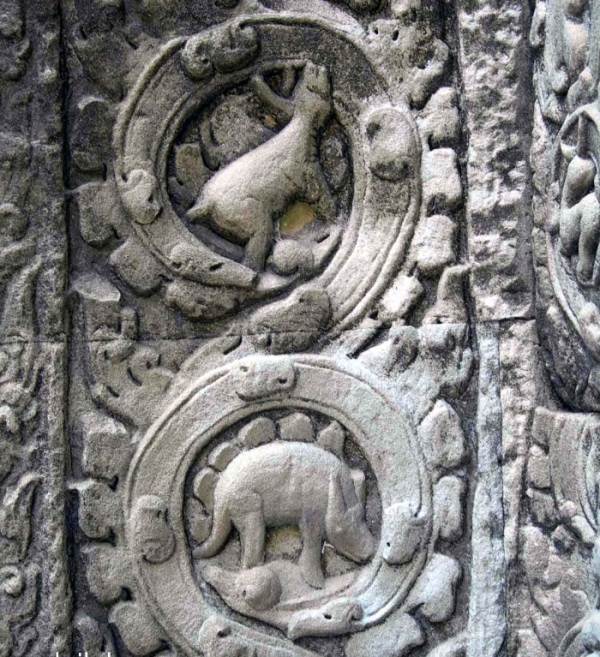
|
|
Fig. 3. Apparent mammal carving with dorsal additions. Credit: www.bible.ca |
After the fall of the Khmer empire in the 15th century, the Angkor temples were largely abandoned and neglected, until becoming the focus of historical research and restoration efforts during the last two centuries. Recently the temples became widely known after being featured in the 2001 Lara Croft movie Tomb Raider. Unlike many heavily restored Angkor temples, Ta Prohm was left largely in its natural state. Dense vegetation, including large trees with vine-like branches and massive roots, cover and entangle many of the ruins, making it a popular destination for photographers and tourists. However, in the last several years efforts have been made to clear some of the brush, build viewing and photography decks, and otherwise accommodate tourist traffic in ways that may detract from the natural beauty of the site.
Among the images carved into the temple walls as bas-relief sculptures are many religious and mythical figures, as well a variety of animals. Some of the animals can be identified to a group level (such as water birds, parrots, deer, and monkeys) whereas others are more ambiguous, such as the image in question. This carving was first brought to widespread attention in two books by Claude Jacques and Michael Freeman (1997, 1999), who remarked that one of the carvings at the temple complex "bears a striking resemblance to a stegosaurus" (1997, p. 213).
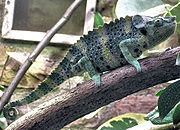
|
| Fig. 4. Cameaelo melleri (Meller's Chameleon) |
In recent years, Don Patton, Carl Baugh, Dennis Swift, and a few other young-earth creationists have claimed that the carving demonstrates that dinosaurs lived alongside humans less than a thousand years ago. They further suggest that it supports their young-earth creationist position in general, which holds that the earth and all life forms were created only several thousand years ago. Patton and Swift personally visited the temple site in early 2006. Patton strongly promotes the stegosaur interpretation on his Bible.ca website (Patton, 2006), where he declares, "One of the animals enclosed in these circles is a stegosaurus." He calls the evidence "amazing." Carl Baugh sells replicas of the carving at his Creationevidence.com website, where he matter-of-factly calls the carving a Stegosaurus. He also has an outdoor display devoted to the find at his little "Creation Evidence Museum" in Texas, where the Stegosaurus conclusion is strongly encouraged. Kyle Butt and Eric Lyons (2008) largely repeat and elaborate on Patton's claims, including the supposedly compelling point that middle school students readily identify the carving as a Stegosaurus. These promotions have prompted discussions on various blogs and websites devoted to creation-evolution issues, cryptozoology, and related topics (Burns, 2010; Meyers, 2009; Dunning, 2010), with many people weighing in with their assessments and interpretations.
Even the major creationist organization AIG ("Answers in Genesis"), which is usually more cautious about alleged "out of order" artifacts and fossils, encourages the stegosaur interpretation in an article at its website (Cole, 2007). Although conceding that the carving might be a forgery, Cole implies that if it's genuine, it probably depicts a recently living stegosaur--without considering alternate explanations and candidates. Similarly, the Institute for Creation Research (ICR) does not take a firm stance but encourages the Stegosaur interpretation (Thomas, 2013). Meanwhile, many old-earth creationists and serious cryptozoologists (e.g. Loren, 2006), and mainstream authors have been more skeptical, pointing to a number of serious problems with the stegosaur interpretation and offerring alternate explanations (Konkus, 2010; Nelstead, 2009; Novella, 2008; Peter, 2013).
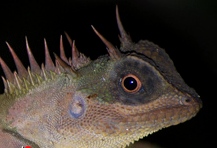
|
|
Fig. 4b. Acanthosaura armata "Mountain Horned lizard" |
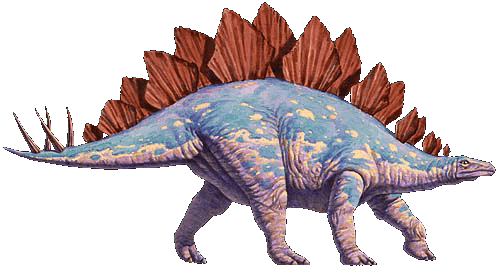
|
| Fig. 5. Stegosaurus reconstruction |
ICR writer Brian Thompson calls the statue an "anatomically correct" stegosaur. However, this is far from the case, and ignores several glaring differences between the carving and a real stegosaur. As further discussed below, these include the lack of tail spikes, the size and shape of the head, the apparent presence of horns (or external ears?), and the proportions of the body and legs, Indeed, the only feaures that could be argued to be significantly stegosaur-like are the lobes along the back, but even these have anatomic problems, and a more likely explanation. On actual stegosaur skeletons, the plates are typically more numerous, in double rows, more pointed and triangular, and larger toward the middle of the back than the head or tail. One might argue that the plates could have been stylized or similfied by the artist, but this does not go far, since a larger problem exists. That is, similar lobes (evidently representing decorative, floral flourishes) occur on many other animal carvings at the temple, including a bird and an apparent water buffaly, where they are virtually identical to the "plates" on the carving in question, but are clearly not back plates.
Some have also noted that the lobes appear to be well delineated from the body, further suggesting that they were not intended to be parts of it. Even if the lobges did represent parts of the animals body (which seems unlikely), it would provide little help to the stegosaur proponents, since they could represent the exaggerated spines or ridges on the backs of chameleons or other lizards (Fig 4). One interesting lizard native to Cambodia and other parts of East Asia is the Mountain Horned Lizard (also called the Horned Dragon) not only has dorsal spines, but also has "horns" projecting from the back of the head. These seem to correspond well with similar projections on the head of the "stegosaur" carving, although the large number of thin spines along the back would not.

|
|
Fig. 6. Bird carving with lobes around its body Credit: www.bible.ca |
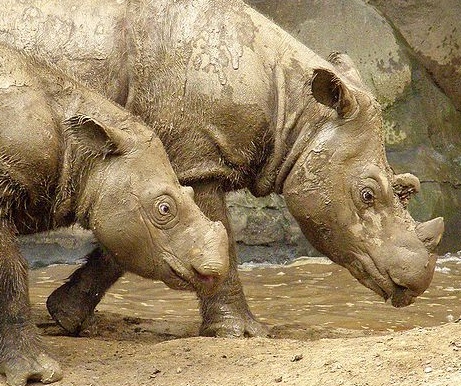
|
|
Fig. 7. Sumatran rhinos in Cincinnati Zoo. Credit: Wikipedia
|
Most other aspects of the creature are not very stegosaur like, and are actually more compatible with a rhinoceros or chameleon. Specifically, stegosaurs (Fig. 5) had tiny heads with pointed, narrow snouts, and rather long, tapering necks--nothing like large head, wide snout, and short neck seen in the carving.
Another signigificant problem for the stegosaur adherents is the lack of tail spikes on the carving. These manacing weapons, often called "thagomizers" after a Gary Larson cartoon, are among the most unique and stunning features of stegosaurs, and not something an artist would easily overlook. The carving also shows front and hind legs of similar size, even though stegosaurs had rear legs far larger than the front legs. Moreover, two large projections are seen at the back of the head on the carved creature. No such features would be expected on a stegosaur. However, they could readily represent ears on a rhino (Figs. 7 & 8), or the folds or furrows of a chameleon neck frill (Fig 4a), or as noted earlier, the spikes on the head of a horned lizard (Fig. 4b). It seems unlikely that a carver familiar with living stegosaurs would neglect striking features such as long tail spikes, but add prominent features on the head that did not exist. If one argues that the image might be so stylized that this is possible, then no anatomic features of the creature can be trusted to be very realistic or meaningful. Indeed, as one blogger (Rogue, 2009) observed, if the carving is really supposed to be a Stegosaurus, it gets things remarkably wrong at both ends.
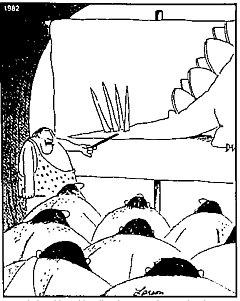
|
|
Now this end is called the Thagomizer... after the late Thag Simmons |

|
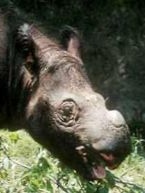
|
| Fig. 8. Carving head compared to baby Asian Rhino | |
Some have objected to the rhino interpretation based on the apparent lack of a nose horn on the carving. However, others note that if one looks closely a hint of a nose horn can be detected (and perhaps was originally clearer, before centuries of weathering). Also, the Borneo Rhino (also called the Sumatran Rhino), whose range formerly included much of east Asia, has a much smaller horn than other species. In females and young juveniles the nose horn ranges from very small to virtually absent (Fig. 7). The bodies and tails of rhinos would match the carving less well, but again, the head is considerably more rhino-like than stegosaur-like. Indeed, general shape and collective features of the head seem to match a rhinoceros better than any other animal. Considering the evidence that the back lobes my be merely decorative additions, on balance it appears that if the carving represents any real creature, a rhinoceros or chameleon seem like more plausible candidates than a recently living stegosaur.
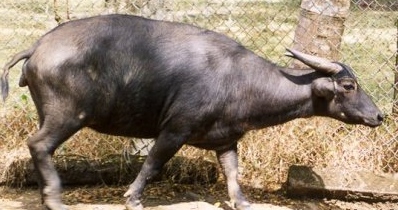
|
|
Fig. 9. Mindoro Dwarf Buffalo (Tamaraw) Credit: Ultimateungulate.com
|
Another consideration not discussed by most stegosaur proponents is that even if the artist meant to depict a stegosaur, he didn't necessarily observe a live one. It's possible that the carving was based on a fossil stegosaur. Stegosaurids are known several areas of the world, including North America, Europe, Africa and East Asia. Although fossil finds are not frequent or plentiful in heavily vegetated areas like Cambodia, several stegosaur genera have been reported from the Jurassic of China (which once shared its southern boarder with the Khmer Empire). These include Huayangosaurus, Tuojiangosaurus, Chungkingosaurus, Chialingosaurus, and Wuerhosaurus. Moreover, as a blogger astutely pointed out, a massive amount of stones must have been quarried for Ta Prohm and the many other temples and stone structures in the region, providing ample opportunities for fossil discoveries. As another blogger commented, it would not be necessary for the fossils to be located in Cambodia itself or even nearby areas. Many ancient peoples traveled quite widely at times, and recounted their adventures and discoveries upon their return. ICR's Brian Thompson calls the ideal of the carving being based on fossils "highly unlikely" because the closest fossils are in "far away" China. This is misleading at best, since China is a neighboring country only several hundred miles to the north, and travel between China and Cambodia was already occurring during the time the temple was made.

|
|
Tuojiangosaurus skeleton, China Credit: Nanjing Museum of Paleontology |
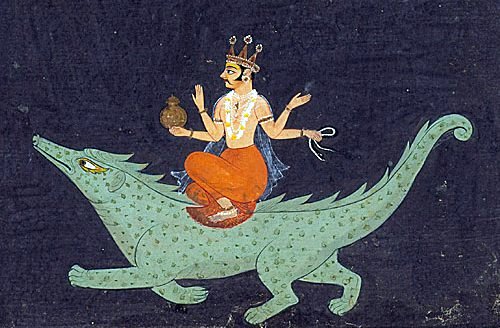
|
|
Fig. 10. The God Varuna on his mount Makara, c. 1675-1700
Credit: Wikipedia |
Yet another possibility is that the animal is largely imaginative or religiously symbolic. Just because some carvings on the temple depict real creatures does not mean that all do. Hindu lore and many temple carvings represent entities featuring combinations of different animals and deities. Some of these could have been the inspiration or basis for the "stegosaur" carving. For example, a Hindu creature named Makara (Fig. 10) is often depicted with dorsal projections, being ridden by a four-armed deity named Varuna or Varundva. While some young earth creationists might suggest that the former creature also represents a dinosaur, most scholars consider it merely mythical or symbolic, perhaps based loosely on local animals (in some renditions, it looks somewhat lizard or crocodile like, in others, more dog or wolf like). Among the more fanciful and strange depictions at Ta Prohm is a carving at the bottom of the same pillar as the "stegosaur" (Fig. 11), which resembles a cat or dog-like creature standing on its hind legs, with one foreleg holding a torch and the other resembling a bush or wing, yet with a head like a man or monkey, sporting a puffy moustache, necklace, and judges wig, So far Patton has not enlightened us on what living creature this image represents.
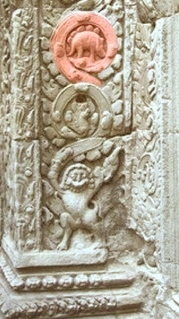
|
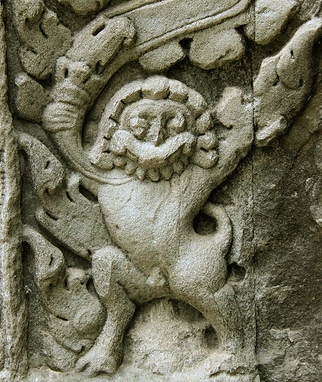
|
|
Fig. 11. Temple pillar showing the "stegosaur" carving and a strange image at the bottom Credit: Colin Burns |
Patton tries to use a series of stegosaur drawings by college art students (and a cartoonish picture frame) to argue that the temple carver almost certainly saw a live stegosaur, since some of the students' drawings showed missing tail spikes, large heads, or other inaccuracies. There are several problems with Patton's analogy and conclusions.
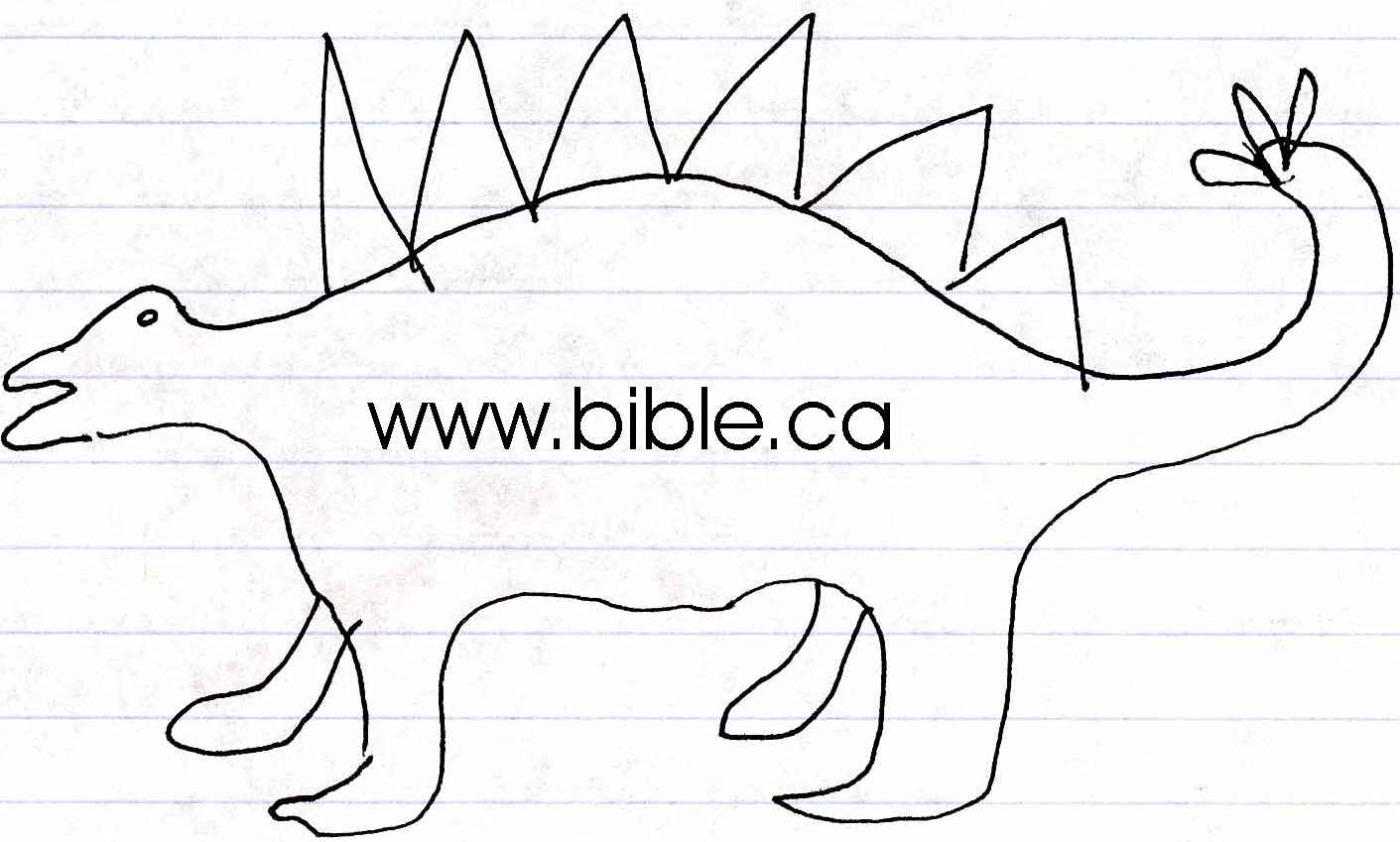
|
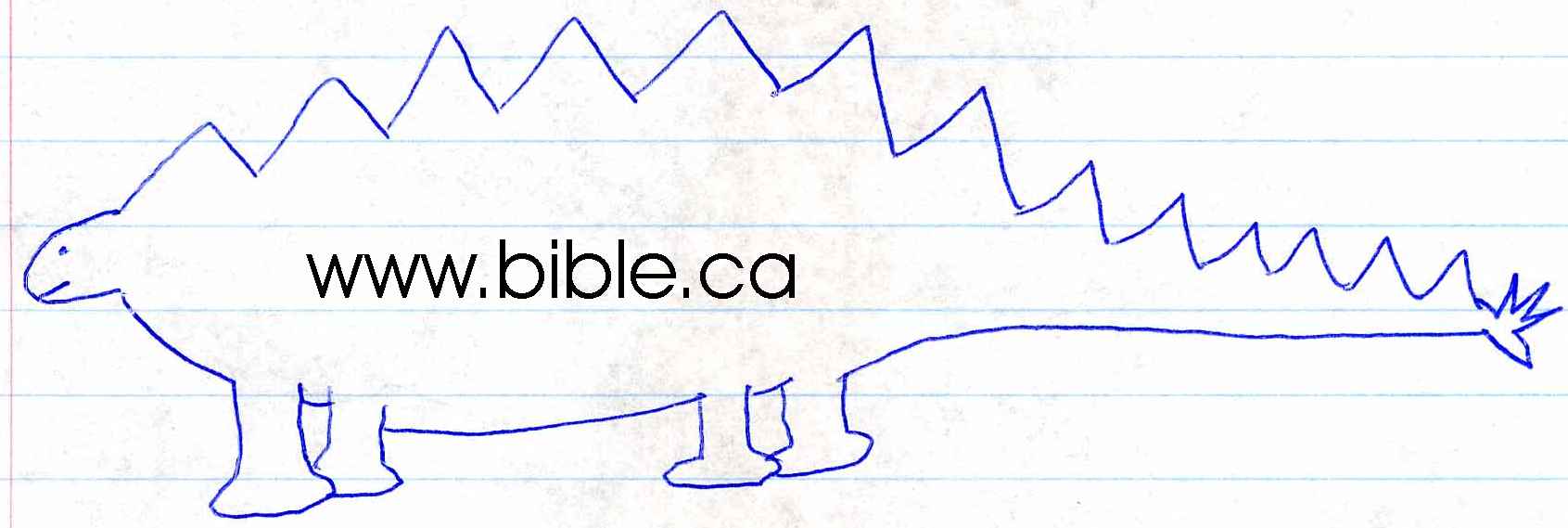
|
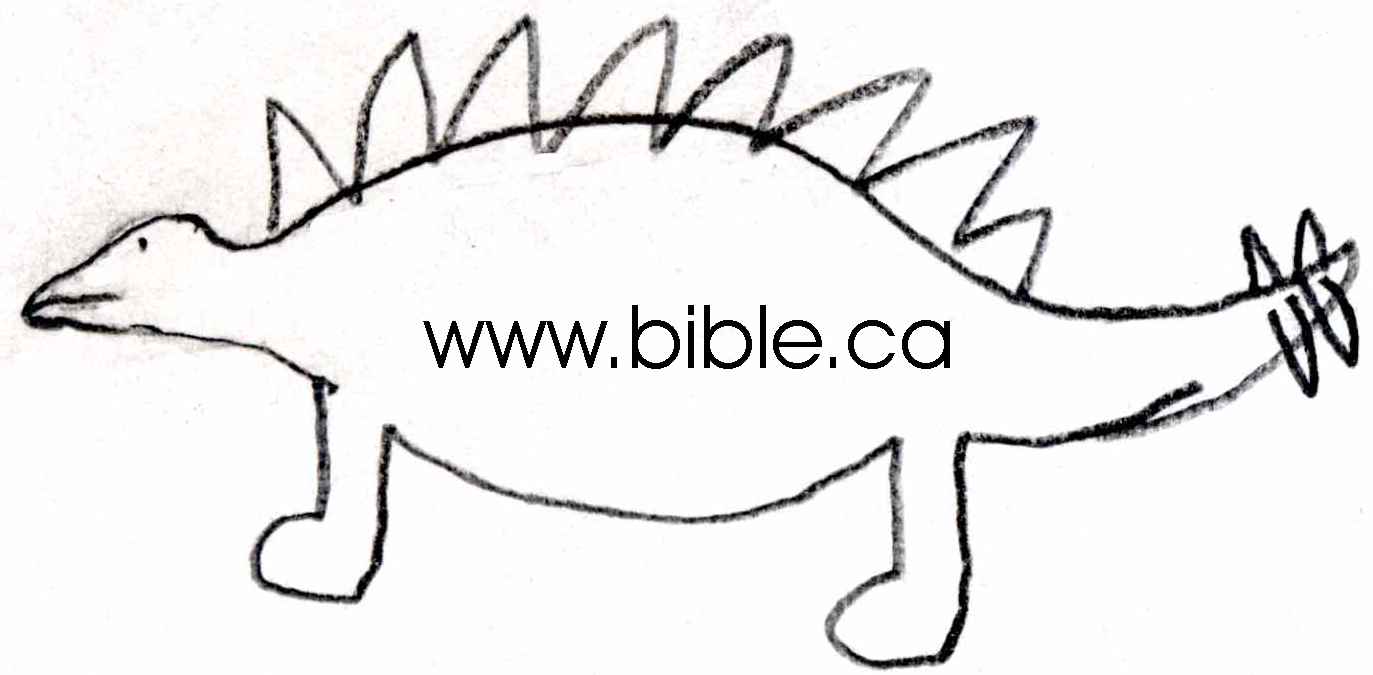
|
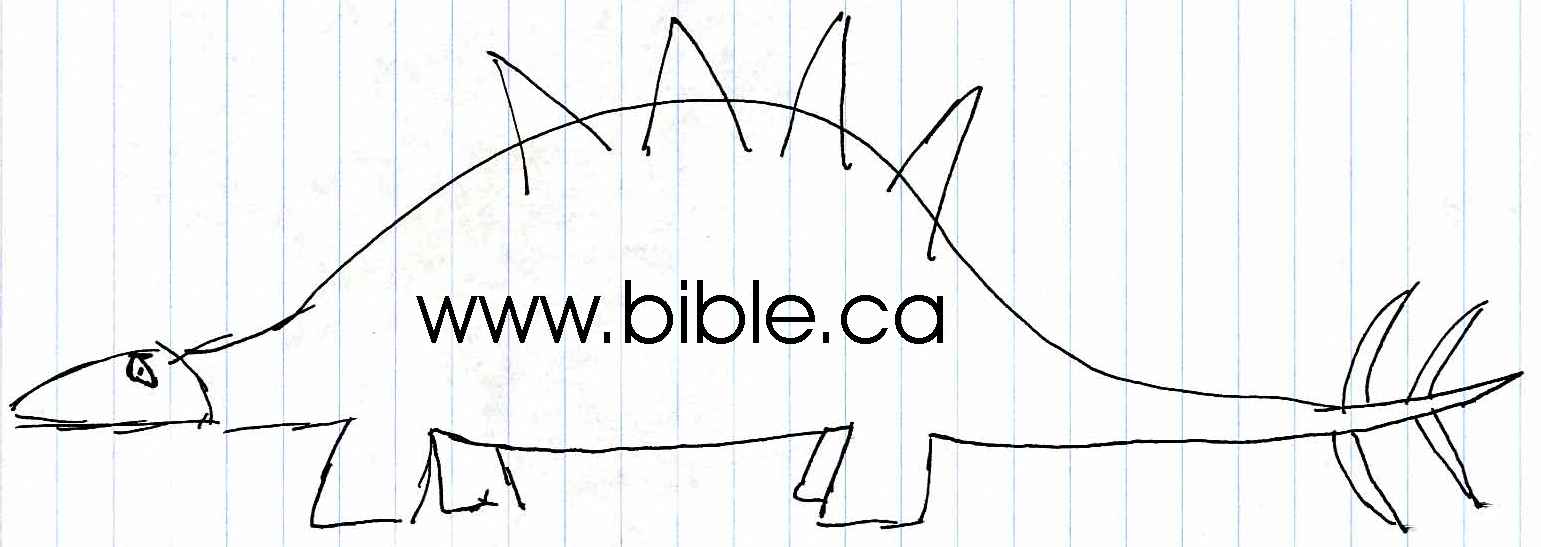
|
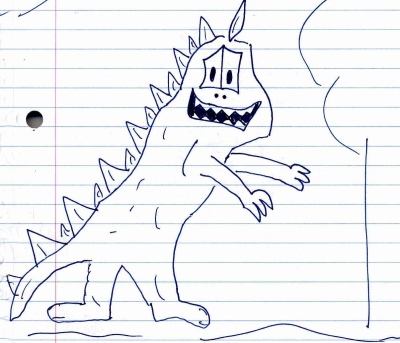
|

|
| Fig. 12. Some of the students' drawings | |
1. Patton says he chose the best drawings to show; however, some look so childish or fanciful (Fig. 12) that if they were
the best, I'd hate to see the worst (perhaps some of the students should consider other majors). Obviously, whoever
drew the smiling, upright dinosaur was just being silly.
2. Even most of the students' drawings show tail spikes, as well as better body/head proportions for a stegosaur than the temple carving.
3. Unlike the temple carving, none of the drawings shows ears or horn-like head projections.
4. Patton ignores the strong possibility that the back lobes might be merely decorations or background vegetation rather than
part of the animal's body.
5. Patton neglects the possibility that even if the image depicts a stegosaur, it could be based on fossils rather than a live stegosaur.
Patton asks, "Does anything other than an anatomically correct portrayal, prove that the artist never saw a good representation of what was being portrayed?" More to the point, he should ask whether an anatomically problematic carving proves that the artist saw a live stegosaur, and clearly it does not. Indeed, in one sense Patton's exercise undermines his own argument. After all, if students can produce semi-accurate depictions of a stegosaur without actually seeing a live one (just a skeleton or someone else's depiction based on a fossil skeleton) so could a Cambodian artist.
Patton further asks, "How, then, should we assess the assertion that the Cambodian sculptor never saw a Stegosaurs because his depiction is imperfect (though better than the art students)? The students must have seen a Stegosaurs but the Cambodian sculptor did not??? ... Prejudice has the power to makes us look awfully ridiculous." First, not all critics insist the artist could not have seen a live dinosaur (some concede it is a remote possibility), but most rightly feel the burden of proof is on those making the extreme claim of a recently living stegosaur, not on others to disprove it (viable alternate explanations alone undermine such claims). Second, Patton again seems to forget that none of the students has ever seen a live stegosaur. Indeed, even the most realistic renderings of stegosaurs by paleo-artists today are not based on live dinosaurs, but fossil skeletons. And again, apparently Patton fails to consider that the lobes along the back of the carving animal may not even be part of its body. So, his logic is more flawed than those he ridicules.
Yet another consideration is the lack of any written records or other reliable corroborating evidence that live stegosaurs were seen in Cambodia only several hundred years ago. Are we to suppose that such massive and stunning creatures were traipsing around a heavily populated area (which was one of the most civilized and advanced cultures of its day), or even seen in areas they visited or explored, without any of them (and many were literate) clearly describing them? Granted, Patton, Baugh, and Swift also promote alleged human and dinosaur depictions on stones or statures from other areas, such as the so-called "Ica Stones" from Peru (which supposedly even show humans riding pterodactyls), and figurines from Acámbaro, Mexico. However, both collections are considered hoaxes by virtually all serious archaeologists (Blanton, 1999; Ross, 2007; Kuban 2008), and are rejected or questioned even by many creationists.
Last, Patton and associates seem to assume without basis that if stegosaurs survived into historic times, it would represent stupendous anti-evolutionary evidence. Quite the contrary, all it would mean is that a member of a dinosaur group thought to have gone extinct survived considerably longer than originally thought. While it would be a wonderful find, it would no more refute conventional geology than did the Ginkgo, Dawn Redwood, or coelacanths (Morton, 2003). What young earth creationists need to refute evolution is not this situation, but essentially the opposite: modern creatures known only from recent epochs (such as humans, deer, dogs, cats, whales, bears, elephants, horses, etc) appearing far earlier than any reasonable evolutionary model allows--such as the early Mesozoic, or anywhere in the Paleozoic. By young earth models we should find countless thousands of well documented examples like this, but not one well verified one exists. Smaller creationist groups and individuals who have promoted the stegosaur claims or similar ones uncritically--assuming that if an object resembles a prehistoric animal, that's what it must be--would do well to reexamine their approach, and consider whether it is advancing creationist credibility, or the opposite.
Blanton, John. 1999. "The Acambaro dinosaurs". The Newsletter of The North Texas Skeptics, Volume 13, Number 10.
http://www.ntskeptics.org/1999/1999october/october1999.htm.
Also see the Wikipedia article on the Acambaro figurines at:
http://en.wikipedia.org/wiki/Ac%C3%A1mbaro_figures
Burns, Colin and Tracy. 2010. "Stegosaurus, Rhinoceros or Hoax? Dinosaur Hunting at Ta Phrom" Travel website and blog at:
http://ourtravellifestyle.com/2010/06/28/stegosaurus-rhinoceros-or-hoax-dinosaur-hunting-at-ta-phrom/
Butt, Kyle, and Eric Lyons. 2008. "Physical Evidence for the Coexistence of Dinosaurs and Humans [Part I]"
Reason & Revelation, 28[3]:17-23
Available as web article at:
http://www.apologeticspress.org/articles/3626
Cole, Kenneth. 2007. "Evidence of Dinosaurs at Angkor." AIG Website article at: http://www.answersingenesis.org/articles/2007/01/15/evidence-dinosaurs-angkor
Coleman Loren. 2006. "Stegosaur in Cambodia?" Cryptomungo.com website postings (with numerous replies) at: http://www.cryptomundo.com/cryptozoo-news/dino-cambodia/
Dunning, Brian. 2010. "Dinosaurs Among Us" Skeptoid #207, Web article at: http://skeptoid.com/episodes/4207
Freeman, Michael and Jacques, Claude. 1997. Angkor Cities and Temples. River Books, Bangkok.
Freeman, Michael and Jacques, Claude. 1999. Ancient Angkor. River Books, Bangkok.
ICR (Insittute for Creation Reasearch). "Men and Doinsaurs Coexisted." Anonymous web article at:
http://www.icr.org/men-dinosaurs/
Oddly, the article features a large uncaptioned photo of the carving at the top of the page, but does not discuss or specifically mention the carving
anywhere in the article.
Konkus, 2010. "The Stegosaurus Carving That Isn't" Web article at: http://www.stupiddinosaurlies.org/the-stegosaurus-carving-that-isn-t
Kuban, Glen. 2010a. "Living Pterosaurs?" Web article at: http://paleo.cc/paluxy/livptero.htm
Kuban, Glen. 2010b. "Dinosaurs in Ancient Art" Web article at: http://paleo.cc/ce/dino-art.htm
Kuban, Glen. 1994. "Overview of Dinosaur Tracking" Web article at: http://paleo.cc/paluxy/ovrdino.htm
Meyers, Stephen. 2008. "Don Patton: Stegosuarus at Ta Prohm Temple in Cambodia?" Web article at: http://www.bibleandscience.com/otherviews/Don%20Patton.htm
Mayor, Adrienne, 2000. The First Fossil Hunters: Paleontology in Greek and Roman Times. Princeton University Press
Morton, Glenn R. 2003. "Living Fossils--There are None" Web article at: https://morton-yec-archive.blogspot.com/2016/04/living-fossils-there-are-none.html
Nelstead, Kevin. 2009. "Stegosaurus in Cambodian temple?" blog discussion at GeoChristian web site.
Novella, Steven. 2008. "Ancient Cambodian Stegosaurus?" Blog article at: http://theness.com/neurologicablog/?p=196
Patton, Don. 2006. "Dinosaurs in ancient Cambodian temple: Amazing evidence that dinosaurs and humans coexisted" Web article at: http://www.bible.ca/tracks/tracks-cambodia.htm
"Peter" (only first name given), 2013. "But Where is the Thagomizer?" Blog entry at: http://eyeonicr.wordpress.com/2013/06/24/thagomizer-mahendraparvata-ta-prohm/#more-6527
Rogue06 (blog ID). 2009. "Carving of a Cambodian Stegosaurus?" Blog article at: http://www.theologyweb.com/campus/showthread.php?134856-Carving-of-a-Cambodian-Stegosaurus
Ross, Sara. 2007. "The Ica Stones and Dr. Javier Cabrera" Web article at: http://pseudoarchaeology.org/b03-ross.html
Swift, Dennis. 2010. "Ancient Dinosaur Depictions." Web article at: http://www.genesispark.com/genpark/ancient/ancient.htm
Thamas, Brian. 2013. "Jungle-Covered Ruins May Hold Surprising Hints." ICR web article at: Wikipedia article (2010) at: http://en.wikipedia.org/wiki/Ta_Prohm